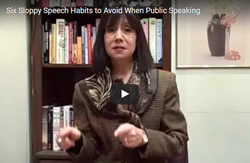You may look like a million but if you want to close a big sale, gain approval from a co-op, or interview for a board position, looks aren’t everything. How you sound is equally as important. But many presenters let careless speech habits sink their chances of making a positive impression and reaching their goals. Here are six common speaking mistakes and how to keep them from sabotaging your presentation success. Watch the video and read Diane’s tips below.
https://youtu.be/1geJXMFCfF8
1. Non-words:
Filler words such as “um,” “ah,” “you know”, “OK” or “like” tell the listener you’re not prepared and make you sound like a Valley Girl (or Boy). A better strategy is to think before you speak, taking pauses and breaths when you lose your train of thought. Everybody utters an occasional “um,” but don’t start every sentence with fillers or non-words.
2. "Up-talk":
A singsong or rising inflection at the end of every sentence creates a tentative impression and makes it sound as though you’re asking a question instead of making a definitive statement. You need to speak with conviction when selling yourself in a presentation. Bring your intonation down when ending a sentence to avoid talking up.
3. Grammatical Errors:
The listener may question your education when you use incorrect grammar or slang. Expressions such as “ain’t” “she don’t,” “me and my friend” and “Shoulda went” aren’t appropriate. Be sure you speak in complete sentences and that your tenses agree. The presentation is not the venue for regional expressions or informality.
4. Sloppy Speech:
Slurring words together or dropping the endings of words will impair the clarity of your message. To avoid slurring and increase clarity, speak slowly during a meeting or presentation. Make a list of commonly mispronounced words, and practice saying them into a recorder before the presentation. Some commonly mispronounced words include “aks” for “ask,” “ath a lete” for “athlete,” “thee ATE er” for “theater”, and “dree” for “three.”
5. Speed Talking:
While everybody is a bit anxious when giving a speech or presentation, you don’t want your information to fly by like a speeding bullet. A rapid speaking rate is difficult to follow, and speed talkers are perceived as nervous. Slow down your racing heart by doing some breathing exercises before the meeting. To avoid rushing, listen to the question, and then count two beats in your head before answering. When you finish a sentence, count two beats again before continuing. Don’t be afraid of silence. Embrace it. Pausing is an effective communication technique. The listener needs a few seconds to process what you just said.
6. Weak Speak:
Wimpy words modify or water down your conviction and undermine your position. When you pepper a conversation with “hopefully,” “perhaps,” “I feel,” “kind of” and “sort of,” the message you convey is a lack of certainty. Use power words such as “I’m confident that,” “my track record shows,” “I take the position that,” “I recommend” or “my goal is.” The language you use gives the listener an impression about your level of confidence and conviction.
The Bottom Line
You don’t have to study elocution to speak well. Simply slow down, take time to pronounce all the syllables, and leave the slang at home.
This article is also published on The Three Tomatoes, The Insider's Guide for Wwomen who aren't kids.

